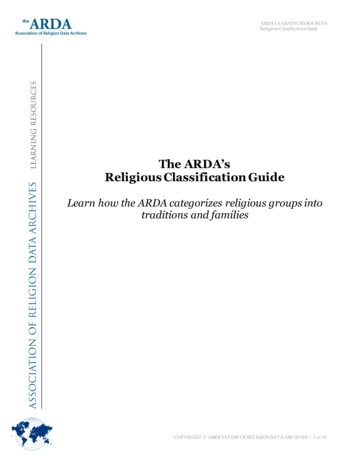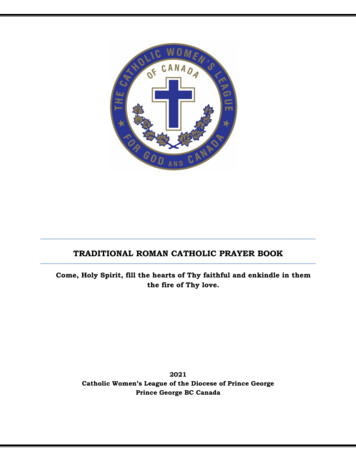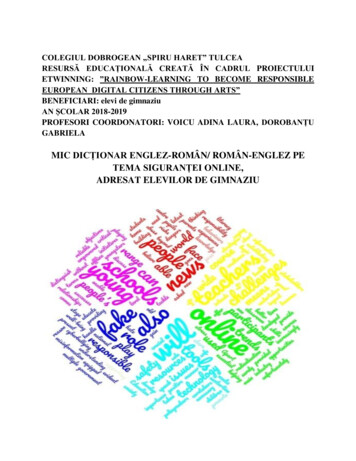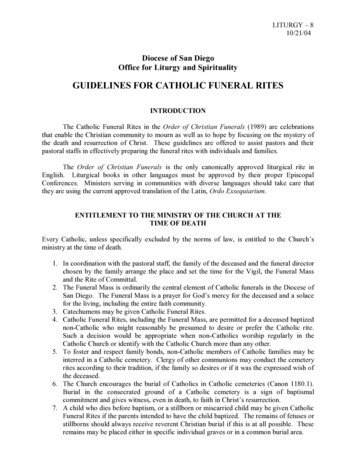
Transcription
TechnologyCurriculum StandardsCatholic Schools OfficeDiocese of ErieAugust, 2014
Table of ContentsPHILOSOPHY STATEMENT . 2TECHNOLOGY CURRICULUM FOUNDATION . 2TECHNOLOGY FOUNDATION STANDARDS FOR STUDENTS . 3PROFILES FOR TECHNOLOGY LITERATE STUDENTS . 5EDUCATIONAL TECHNOLOGY STANDARDS ANDPERFORMANCE INDICATORS FOR TEACHERS . 6EDUCATIONAL TECHNOLOGY STANDARDS ANDPERFORMANCE INDICATORS FOR ADMINISTRATORS . 9Grades K – 2 . 12Grades 3 – 5 . 13Grades 6 – 8 . 14Grades 9 – 12 . 151
Philosophy StatementCurrent and emerging technologies play a prominent role in the education of thewhole child. Access to technologies opens the door to the world beyond theclassroom and increases the students’ chances for success.In our Catholic schools, students shall be instructed to utilize availabletechnologies for education, communication, problem solving, analysis, andresearch in accordance with Catholic values, ethical principles, and moraldecision making. Students shall have the opportunity to locate, process, and useinformation in order to improve their abilities to learn, communicate, reason, andwork.The curriculum of the school will be the foundation of incorporated technologies.The technologies will not be the driving force of the curriculum but rather thetools to achieve an integrated, cross-disciplinary learning environment thatmirrors the real world.Technology Curriculum FoundationThe technology curriculum of the Catholic Diocese of Erie includes conceptformation and processes expressed by performance indicators. Each level of thecurriculum has cross-curricular objectives that encompass hands-on approachesto student learning. The Catholic Diocese of Erie has adopted the ISTE NationalEducation Technology Standards (NETS) and these are correlated with thePennsylvania State Academic Standards for Science and Technology.2
NETS (National Educational Technology Standards) for StudentsTechnology Foundation Standards for All StudentsThe technology foundation standards for students are divided into six broadcategories. Standards within each category are to be introduced, reinforced, andmastered by students. These categories provide a framework for linkingperformance indicators within the Profiles for Technology Literate Students to thestandards. Teachers can use these standards and profiles as guidelines forplanning technology-based activities in which students achieve success inlearning, communication, and life skills.Technology Foundation Standards for StudentsT1. Creativity and InnovationStudents demonstrate creative thinking, construct knowledge, and developinnovative products and processes using technology. Students:apply existing knowledge to generate new ideas, products, orprocesses.T1.b. create original works as a means of personal or group expression.T1.c. use models and simulations to explore complex systems and issues.T1.d. identify trends and forecast possibilities.T1.a.T2. Communication and CollaborationStudents use digital media and environments to communicate and workcollaboratively, including at a distance, to support individual learning andcontribute to the learning of others. Students:T2.a. interact, collaborate, and publish with peers, experts, or othersemploying a variety of digital environments and media.T2.b. communicate information and ideas effectively to multipleaudiences using a variety of media and formats.T2.c. develop cultural understanding and global awareness by engagingwith learners of other cultures.T2.d. contribute to project teams to produce original works or solveproblems.3
T3. Research and Information FluencyStudents apply digital tools to gather, evaluate, and use information.Students:T3.a. plan strategies to guide inquiry.T3.b. locate, organize, analyze, evaluate, synthesize, and ethically useinformation from a variety of sources and media.T3.c. evaluate and select information sources and digital tools based onthe appropriateness to specific tasks.T3.d. process data and report results.T4. Critical Thinking, Problem Solving, and Decision MakingStudents use critical thinking skills to plan and conduct research, manageprojects, solve problems, and make informed decisions using appropriatedigital tools and resources. Students:T4.a. identify and define authentic problems and significant questions forinvestigation.T4.b. plan and manage activities to develop a solution or complete aproject.T4.c. collect and analyze data to identify solutions and/or make informeddecisions.T4.d. use multiple processes and diverse perspectives to explorealternative solutions.T5. Digital CitizenshipStudents understand human, cultural, and societal issues related totechnology and practice legal and ethical behavior. Students:T5.a. advocate and practice safe, legal, and responsible use of informationand technology.T5.b. exhibit a positive attitude toward using technology that supportscollaboration, learning, and productivity.T5.c. demonstrate personal responsibility for lifelong learning.T5.d. exhibit leadership for digital citizenship.4
T6. Technology Operations and ConceptsStudents demonstrate a sound understanding of technology concepts,systems, and operations. Students:T6.a.T6.b.T6.c.T6.d.understand and use technology systems.select and use applications effectively and productively.troubleshoot systems and applications.transfer current knowledge to learning of new technologies. 2007 International Society for Technology in Education. ISTE is a registeredtrademark of the International Society for Technology in Education.Profiles for Technology Literate StudentsA major component of the NETS Project is the development of a general set of profilesdescribing technology (ICT) literate students at key developmental points in theirprecollege education. The profiles highlight a few important types of learning activities inwhich students might engage as the new NETS S are implemented. These examples areprovided in an effort to bring the standards to life and demonstrate the variety ofactivities possible. The profiles are divided into the following four grade ranges.1.2.3.4.Pre-school – grade 2Grades 3 -5Grades 6 – 8Grades 9 – 12Reference the individual standards charts for each grade range.5
NETS (National Educational Technology Standards) for TeachersEducational Technology Standards and Performance Indicators for Teachers1. Facilitate and Inspire Student Learning and CreativityTeachers use their knowledge of subject matter, teaching and learning, and technology tofacilitate experiences that advance student learning, creativity, and innovation in bothface-to-face and virtual environments. Teachers:a. promote, support, and model creative and innovative thinking andinventiveness.b. engage students in exploring real-world issues and solving authenticproblems using digital tools and resources.c. promote student reflection using collaborative tools to reveal and clarifystudents' conceptual understanding and thinking, planning, and creativeprocesses.d. model collaborative knowledge construction by engaging in learning withstudents, colleagues, and others in face-to-face and virtual environments.2. Design and Develop Digital-Age Learning Experiences and AssessmentsTeachers design, develop, and evaluate authentic learning experiences and assessmentincorporating contemporary tools and resources to maximize content learning in contextand to develop the knowledge, skills, and attitudes identified in the NETS S. Teachers:a. design or adapt relevant learning experiences that incorporate digital toolsand resources to promote student learning and creativity.b. develop technology-enriched learning environments that enable all studentsto pursue their individual curiosities and become active participants insetting their own educational goals, managing their own learning, andassessing their own progress.c. customize and personalize learning activities to address students' diverselearning styles, working strategies, and abilities using digital tools andresources.6
d. provide students with multiple and varied formative and summativeassessments aligned with content and technology standards and useresulting data to inform learning and teaching.3. Model Digital-Age Work and LearningTeachers exhibit knowledge, skills, and work processes representative of an innovativeprofessional in a global and digital society. Teachers:a. demonstrate fluency in technology systems and the transfer of currentknowledge to new technologies and situations.b. collaborate with students, peers, parents, and community members usingdigital tools and resources to support student success and innovation.c. communicate relevant information and ideas effectively to students,parents, and peers using a variety of digital-age media and formats.d. model and facilitate effective use of current and emerging digital tools tolocate, analyze, evaluate, and use information resources to support researchand learning.4. Promote and Model Digital Citizenship and ResponsibilityTeachers understand local and global societal issues and responsibilities in an evolvingdigital culture and exhibit legal and ethical behavior in their professional practices.Teachers:a. advocate, model, and teach safe, legal, and ethical use of digitalinformation and technology, including respect for copyright, intellectualproperty, and the appropriate documentation of sources.b. address the diverse needs of all learners by using learner-centered strategiesproviding equitable access to appropriate digital tools and resources.c. promote and model digital etiquette and responsible social interactionsrelated to the use of technology and information.d. develop and model cultural understanding and global awareness byengaging with colleagues and students of other cultures using digital-agecommunication and collaboration tools.7
5. Engage in Professional Growth and LeadershipTeachers continuously improve their professional practice, model lifelong learning, andexhibit leadership in their school and professional community by promoting anddemonstrating the effective use of digital tools and resources. Teachers:a. participate in local and global learning communities to explore creativeapplications of technology to improve student learning.b. exhibit leadership by demonstrating a vision of technology infusion,participating in shared decision making and community building, anddeveloping the leadership and technology skills of others.c. evaluate and reflect on current research and professional practice on aregular basis to make effective use of existing and emerging digital toolsand resources in support of student learning.d. contribute to the effectiveness, vitality, and self-renewal of the teachingprofession and of their school and community. 2008 International Society for Technology in Education. ISTE is a registeredtrademark of the International Society for Technology in Education.8
NETS (National Educational Technology Standards) for AdministratorsEducational Technology Standards and Performance Indicators for Administrators1. Visionary LeadershipEducational Administrators inspire and lead development and implementation of a sharedvision for comprehensive integration of technology to promote excellence and supporttransformation throughout the organization. Educational Administrators:a. inspire and facilitate among all stakeholders a shared vision of purposefulchange that maximizes use of digital-age resources to meet and exceedlearning goals, support effective instructional practice, and maximizeperformance of district and school leaders.b. engage in an ongoing process to develop, implement, and communicatetechnology-infused strategic plans aligned with a shared vision.c. advocate on local, state and national levels for policies, programs, andfunding to support implementation of a technology-infused vision andstrategic plan.2. Digital Age Learning CultureEducational Administrators create, promote, and sustain a dynamic, digital-age learningculture that provides a rigorous, relevant, and engaging education for all students.Educational Administrators:a. ensure instructional innovation focused on continuous improvement ofdigital-age learning.b. model and promote the frequent and effective use of technology forlearning.c. provide learner-centered environments equipped with technology andlearning resources to meet the individual, diverse needs of all learners.d. ensure effective practice in the study of technology and its infusion acrossthe curriculum.9
e. promote and participate in local, national, and global learning communitiesthat stimulate innovation, creativity, and digital-age collaboration.3. Excellence in Professional PracticeEducational Administrators promote an environment of professional learning andinnovation that empowers educators to enhance student learning through the infusion ofcontemporary technologies and digital resources. Educational Administrators:a. allocate time, resources, and access to ensure ongoing professional growthin technology fluency and integration.b. facilitate and participate in learning communities that stimulate, nurtureand support administrators, faculty, and staff in the study and use oftechnology.c. promote and model effective communication and collaboration amongstakeholders using digital-age tools.d. stay abreast of educational research and emerging trends regardingeffective use of technology and encourage evaluation of new technologiesfor their potential to improve student learning.4. Systemic ImprovementEducational Administrators provide digital-age leadership and management tocontinuously improve the organization through the effective use of information andtechnology resources. Educational Administrators:a. lead purposeful change to maximize the achievement of learning goalsthrough the appropriate use of technology and media-rich resources.b. collaborate to establish metrics, collect and analyze data, interpret results,and share findings to improve staff performance and student learning.c. recruit and retain highly competent personnel who use technologycreatively and proficiently to advance academic and operational goals.d. establish and leverage strategic partnerships to support systemicimprovement.10
e. establish and maintain a robust infrastructure for technology includingintegrated, interoperable technology systems to support management,operations, teaching, and learning.5. Digital CitizenshipEducational Administrators model and facilitate understanding of social, ethical and legalissues and responsibilities related to an evolving digital culture. EducationalAdministrators:a. ensure equitable access to appropriate digital tools and resources to meetthe needs of all learners.b. promote, model and establish policies for safe, legal, and ethical use ofdigital information and technology.c. promote and model responsible social interactions related to the use oftechnology and information.d. model and facilitate the development of a shared cultural understandingand involvement in global issues through the use of contemporarycommunication and collaboration tools. 2009 International Society for Technology in Education. ISTE is a registeredtrademark of the International Society for Technology in Education.11
Technology Standards: 1. Creativity and Innovation2. Communication and Collaboration 3. Research and Information Fluency12 4. Critical Thinking, Problem Solving, and Decision Making 5. Digital Citizenship 6. Technology Operations and ConceptsExpectations for Grade K - Grade 2Sample Problem / ProjectPacingAssessmentResourcesIllustrate and communicate original ideas and storiesusing digital tools and media-rich resources. (1,2)Identify, research, and collect data on anenvironmental issue using digital resources andpropose an appropriate solution. (1,3,4)Engage in learning activities with learners frommultiple cultures through e-mail and other electronicmeans. (2,6)In a collaborative work group, use a variety oftechnologies to produce a digital presentation orproduct in a curriculum area. Utilize one technologyat a time. (1,2,6)Find and evaluate information related to a current orhistorical person or event using digital resources. (3)Use simulations and graphical organizers to exploreand depict patterns of growth such as the life cycles ofplants and animals. (1,3,4)Demonstrate safe/cooperative use of technology. (5)Independently apply digital tools and resources toaddress a variety of tasks and problems. (4,6)Communicate about technology usingdevelopmentally appropriate and accurateterminology. (6)Demonstrate the ability to navigate in virtualenvironments such as electronic books, simulationsoftware, and Web sites. (6)12
Technology Standards: 1. Creativity and Innovation4. Critical Thinking, Problem Solving, and Decision MakingExpectations for Grade 3 - Grade 52. Communication and Collaboration 3. Research and Information Fluency5. Digital Citizenship 6. Technology Operations and ConceptsSample Problem / ProjectPacingAssessmentResourcesProduce a media-rich digital story about a significantlocal event based on first-person interviews. (1,2,3,4)Use digital-imaging technology to modify or createworks of art for use in a digital presentation. (1,2,6)Recognize bias in digital resources while researchingan environmental issue with guidance from theteacher. (3,4)Select and apply digital tools to collect, organize, andanalyze data to evaluate theories or test hypotheses.(3,4,6)Identify and investigate a global issue and generatepossible solutions using digital tools and resources.(3,4)Conduct science experiments using digital instrumentsand measurement devices. (4,6)Conceptualize, guide, and manage individual or grouplearning projects using digital planning tools withteacher support. (4,6)Practice injury prevention by applying a variety ofergonomic strategies when using technology. (5)Debate the effect of existing and emergingtechnologies on individuals, society, and the globalcommunity. (5,6)Apply previous knowledge of digital technologyoperations to analyze and solve current hardware andsoftware problems. (4,6)13
Technology Standards: 1. Creativity and Innovation4. Critical Thinking, Problem Solving, and Decision MakingExpectations for Grade 6 - Grade 82. Communication and Collaboration 3. Research and Information Fluency5. Digital Citizenship 6. Technology Operations and ConceptsSample Problem / ProjectPacingAssessmentResourcesDescribe and illustrate a content-related concept orprocess using a model, simulation, or conceptmapping software. (1,2)Create original animations or videos documentingschool, community, or local events. (1,2,6)Gather data, examine patterns, and apply informationfor decision making using digital tools and resources.(1,4)Participate in a cooperative learning project in anonline learning community. (2)Evaluate digital resources to determine the credibilityof the author and publisher and the timeliness andaccuracy of the content. (3)Employ data-collection technology such as probes,handheld devices, and geographic mapping systems togather, view, analyze, and report results for contentrelated problems. (3,4,6)Select and use the appropriate tools and digitalresources to accomplish a variety of tasks and to solveproblems. (3,4,6)Use collaborative electronic authoring tools to explorecommon curriculum content from multiculturalperspectives with other learners. (2,3,4,5)Integrate a variety of file types to create and illustratea document or presentation. (1,6)Independently develop and apply strategies foridentifying and solving routine hardware and softwareproblems. (4,6)14
Technology Standards: 1. Creativity and Innovation4. Critical Thinking, Problem Solving, and Decision MakingExpectations for Grade 9 - Grade 122. Communication and Collaboration 3. Research and Information Fluency5. Digital Citizenship 6. Technology Operations and ConceptsSample Problem / ProjectPacingAssessmentResourcesDesign, develop, and test a digital learning game todemonstrate knowledge and skills related tocurriculum content. (1,4)Create and publish an online art gallery with examplesand commentary that demonstrate an understanding ofdifferent historical periods, cultures, and countries.(1,2)Select digital tools or resources to use for a real-worldtask and justify the selection based on their efficiencyand effectiveness. (3,6)Employ curriculum-specific simulations to practicecritical-thinking processes. (1,4)Identify a complex global issue, develop a systematicplan of investigation, and present innovativesustainable solutions. (1,2,3,4)Analyze the capabilities and limitations of current andemerging technology resources and assess theirpotential to address personal, social, lifelong learning,and career needs. (4,5,6)Design a Web site that meets accessibilityrequirements. (1,5)Model legal and ethical behaviors when usinginformation and technology by properly selecting,acquiring, and citing resources. (3,5)Create media-rich presentations for other students onthe appropriate and ethical use of digital tools andresources. (1,5)Configure and troubleshoot hardware, software, andnetwork systems. (4,6)15
NETS (National Educational Technology Standards) for Administrators Educational Technology Standards and Performance Indicators for Administrators 1. Visionary Leadership Educational Administrators inspire and lead development and implementation of a shared vision for comprehensive integration of technology to promote excellence and support










